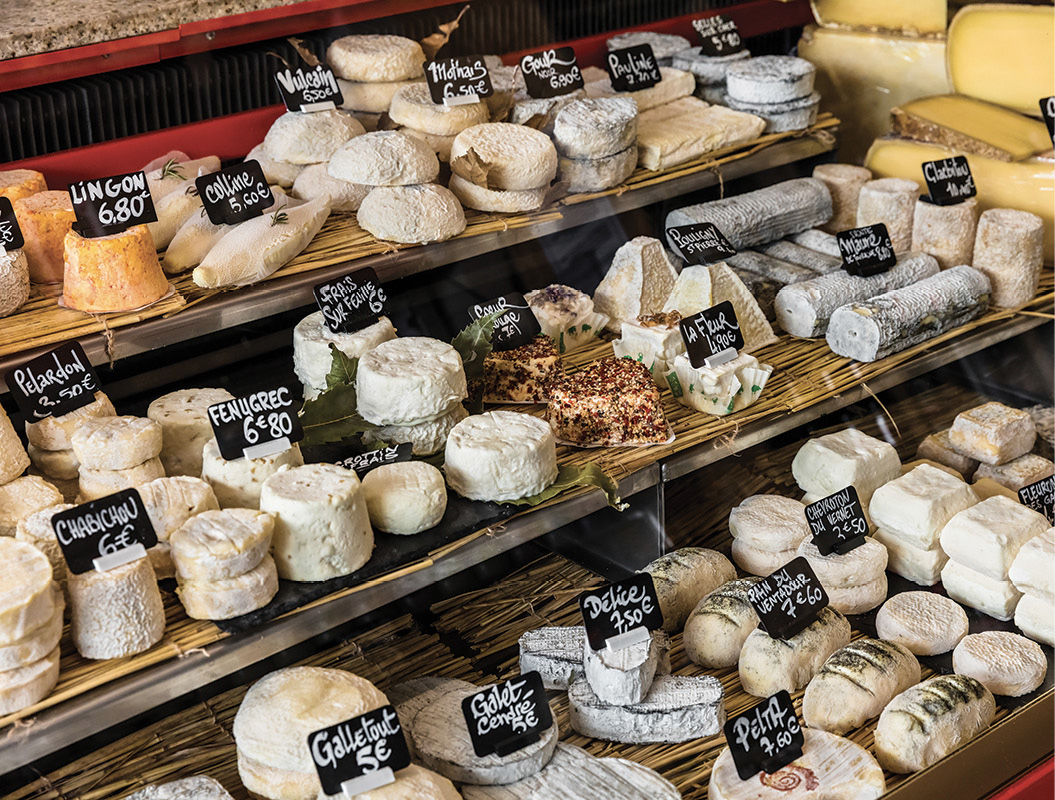Chapter 4
CHEESE, EGGS,
AND DAIRY
(Fromage, Oeufs, et Latier)

Recipes featured in this chapter:
Cherry (Cerise) Compote
Sweet Potato (Patate Douce), Sausage (Saucisse),
and Shallot (Echalote) Crustless Quiche
Crab (Crabe) and Poached Egg Tartine
Tarragon Butter (Beurre d’Estragon)
Anchovy Butter (Beurre d’Anchois) and Radishes (Radis)
Seaweed Butter (Beurre d’Algues)
Cheese (Fromage)
Some experts claim that France now boasts of 275 types of cheese, but others say the number is closer to 500. No matter who is correct, one of Deborah’s and my sworn goals is to try to taste as many of them as we possibly can. France (and much of the rest of the world) does not require cheese to be pasteurized (cooked). This allows natural bacteria to do its job and make cheese the whole world craves. Like wine, fine French cheese is controlled by the AOC (Appellation d’Origine Contrôlée), a French food-labeling term that protects the style, ingredients, and origin of a product. Many of Europe’s oldest food products are protected by similar designations, such as Italy’s DOC (Denominazione di Origine Controllata) and Spain’s DO (Denominación de Origen). That means, for example, that if you buy any cheese called Roquefort, it must have been produced in the Roquefort area of France; likewise the famous Comté must have been made only in the Franche-Comté region in eastern France.
Most of France’s hard cheeses are best kept in a cool, dark, well-ventilated place, not in the refrigerator. They’ll keep better if they are loosely wrapped in paper, not in plastic. Moisture collects between the cheese and the plastic, and it prevents the cheese from breathing correctly.
We once house-sat for friends of ours at their apartment on Butte Montmartre, in Paris. The apartment was in a fabulous 1904 art nouveau building. There was a tiny door next to the outside wall of the kitchen, and the friend who owned the place explained that in many old French buildings there was a garde manger like his. Before refrigeration, it was used to keep food; and if people are lucky enough to have one today, it’s where they can store their cheese. Of course, there are adorable, expensive decorator creations called “cheese safes” for those poor souls who don’t have a garde manger.
Following are some of our favorite cheeses from the seemingly infinite kinds available, and suggestions about how to use them. We encourage you to explore and discover unique local artisanal cheeses. Of course, supermarchés stock cheeses of all sorts, and what you will find depends on the snootiness of the store. Truth be told, you’ll have a better cheese-buying experience in the small shops or farmers’ markets. The sellers will be delighted to give you a short cheese lesson and even a taste of their wares.
Fresh Cheese
Fromage Blanc is a fresh, very soft cow’s-milk cheese, a cross between yogurt and ricotta. It’s made with whole or skimmed milk and cream. Without the cream, it’s virtually fat-free, but of course, cream makes it taste better! It’s used in desserts, as a spread on bread, and in savory dishes.
Petit-Suisse is made from cow’s milk in Pays de Bray. It has a smooth texture and is usually eaten for dessert or breakfast topped with something sweet. It comes in a cylindrical shape in a little plastic tub. You can enjoy it with savory herbs or add it to other ingredients to make a spreadable consistency. It’s sold very fresh and should be consumed soon after you buy it.
Soft Cheese
Brie de Meaux and Brie de Melun are AOC cheeses made from cow’s milk. This is the authentic Brie! Since it is not pasteurized, the cheese has a beefy, buttery flavor and a gorgeous golden color. The tender white crust is eaten, and its mild flavor and creamy consistency should please almost anyone who doesn’t like strong-tasting cheese.
Brillat-Savarin is made in Pays de Bray. It is a triple cream cow’s-milk cheese, extremely soft and creamy. A mature Brillat-Savarin has a white rind with a buttery-white interior. It’s a gorgeous treat with champagne, but then what doesn’t go with champagne? It’s also nice with Viognier.
Camembert is from Normandy. This soft, creamy cheese from cow’s milk is probably the most famous French cheese as well as the most imitated. It should be soft but not too runny when you buy it. If it’s hard, it’s not aged properly. If it’s yellow, it’s seen better days. To be sure of what you’re getting, open the box and press on the cheese. If it’s not soft, move on to something else. Eat the rind as well as the cheese. Properly stored it should last a week in the refrigerator.
Carré de l’Est is a soft-ripened cow’s-milk cheese with a smoky bacon flavor. It is extremely popular in France and can be found almost everywhere in the country.
Chabichou du Poitou is made in the Poitou, Berry, and Périgord regions of France from goat’s milk. Many of these cheeses are sold locally, but since it’s made in both raw and pasteurized versions, it can also be found in the United States. The cheeses are shaped like small cylinders and have a wrinkly rind. When it’s young, it has a clean, mildly sweet goat flavor; and with age, it becomes more chalky with a nutty taste.
Crottin de Chavignol is made in a village near Sancerre from goat’s milk. This is the Loire region’s most famous cheese. Its natural rind can range from pale ivory to almost black, and its interior is a soft flaky white. It can be eaten almost anytime during its ripening process and gets more vibrant as it ages. It’s marvelous served warm in a chèvre salad and perfect for a cheeseboard.
Munster is made in Alsace-Lorraine from cow’s milk and is not at all like the mild American version, which is known as Muenster (notice the slight difference in spelling). The French variety has a much more pungent aroma and an assertive flavor. The rind can be eaten or cut off as you prefer. Although strong, it should never taste acrid. If it does, it’s overripe.
St. André, from Villefranche-de-Rouergue, is a triple cream cow’s-milk cheese. Its high fat content, enhanced with heavy cream, gives it a gloriously buttery taste. Its powdery rind and decadent center make it seem like Brie to the triple power. Think of this cheese with a soft dessert wine or slathered on a crunchy baguette. Excuse me—I have to leave for France right this minute!
Pont-l’Évêque is made in Pays d’Auge from cow’s milk. This is a terrific addition to an after-dinner cheese plate. Eat the orange rind, too. Inside, you’ll find a creamy, soft cheese with a strong aroma but a mild flavor.
Vacherin is made in the Haut-Doubs from pasteurized cow’s milk. It has a grayish-yellow rind that you’ll want to remove. Since it’s covered in pine bark, it has a slight resinous note. It’s very runny, so it’s best served with a spoon. It’s considered a rare and luxurious cheese since it’s produced only from August 15 through March 31.
Semi-Soft Cheese
Comté is from the Franche-Comté region of eastern France. This firm cow’s-milk cheese is made in local village dairies whose methods haven’t changed in hundreds of years. It comes either fruite (fruity) or sale (salty). It’s the traditional cheese of fondue and also is used for raclette. Considered one of the most excellent cheeses in the world, a wedge of Comté has a pale yellow interior and a texture that can vary from smooth to hard. The cheese is aged in caves in the area, and on the labels of some Comté you’ll see the name of the cave in which it matured.
Époisses is made in Semur-en-Auxois, Burgundy, from cow’s milk. It’s semi-soft with an orange rind and a white center that’s almost crumbly. The cheese under the skin is soft. It’s wonderful with red wine.
Mâconnais is made in Mâcon, Burgundy, from goat’s milk, cow’s milk, or a combination of the two. It’s shaped like a cone and is cream colored, but as it ripens it may turn blue. It’s creamy, but as it ages it becomes harder and saltier. Try it with a light red wine like a Beaujolais or a light white like Chablis. This cheese was certified AOC in 2005.
Morbier is made in Franche-Comté from cow’s milk. It’s a semi-soft, ivory-colored cheese that is easy to spot because of its layer of black ash in the middle. The traditional line of ash is now just decoration and has no taste. The cheese is strongly scented and has a yellow rind.
Blue Cheese
Bleu de Bresse is made in Bresse from cow’s milk. It is rich, creamy, and deliciously blue. Its rind is soft and edible like Brie.
Fourme d’Ambert is a cow’s-milk cheese made in Monts du Forez. It is one of the oldest cheeses in France, and legend has it that the Druids and the Gauls were making it in their time. It is the mildest of the blues and is great in salads and on cheese boards.
Roquefort is made in Roquefort-sur-Soulzon from unpasteurized sheep’s milk. This soft, crumbly cheese was reportedly a favorite of the emperor Charlemagne. In France, Roquefort is called the cheese of kings and popes. It is protected by AOC and is aged for five months. Almost anything savory can benefit from a little Roquefort!
Semi-Firm
Beaufort, made of unpasteurized cow’s milk, comes from the same region in the Alps as the Tomme de Savoie. It has a distinct aroma of earth and grass. It’s yellow, with a smooth and creamy texture, and it is a favorite cheese for fondue because it melts quickly. It’s terrific with fish.
Tomme de Savoie is made in the valley of Savoie in the French Alps. The word tomme means a small wheel of cheese, so the name of this cheese really means “cheese from Savoie.” It’s made from skimmed cow’s milk, and it tastes as earthy and rustic as the caves where it is aged. It’s beautiful with walnuts, or try it in a salad with sharp arugula.
Hard
Abondance is from the Haute-Savoie region in the Rhône-Alpes. It is produced from the milk of the Abondance breed of cattle, and this cheese has been AOC designated since 1990. Its strong smell and intensely fruity, buttery flavor make it unique. Its crust and the layer beneath should be removed before eating. It melts well and can be a great addition to a salad.
Cantal is made in Auvergne. It is made from cow’s milk, and it is medium-firm and slightly crumbly. Some say its flavor is reminiscent of a cheddar. You can buy jeune (young) or entre deux (between two), which is the more aged, stronger-tasting variety.
Mimolette is raw cow’s milk cheese with a crunchy yet melt-in-your-mouth texture. It has a bright orange color and a thicker rind, which you should discard. The flavors are well developed at one to two years with hints of toasted nuts, butterscotch, and bacon. It pairs well with Pinot Noir or Grenache.
How to Present the Cheese Course
If you’re following French protocol, the cheese course should be served before the dessert. If you want to skip the dessert, you can opt to serve the cheese with fruit and honey. Or you could combine your salad and cheese course by serving a small wedge of cheese as an accompaniment to your light, simple salad.
For a full cheese course, choose between two and four cheeses that you enjoy. For instance, you could present a blue, a fresh chèvre, an aged soft cheese, and/or a medium-to-hard cheese. Place the cheeses on a board, a cake plate, a platter, or whatever you can find. Add a light accompaniment with each cheese, such as fresh fig with blue cheeses, or apple slices with aged soft cheese. Be sure to serve the cheeses at room temperature so you can experience their full flavor. If you don’t want to do a full cheese course, you can buy one cheese and put a small wedge of it on a small plate for each guest. Try blue cheese drizzled with honey, toasted walnuts, and fresh thyme.
Cheese is rarely served as an appetizer. But rules are made to be broken, so do what makes you happy!
Eggs (Oeufs)
The French, ever mindful of good quality food, have borrowed a free-range system from neighboring Germany in which hens are allowed to leave the barn and enjoy runs alongside the chicken house. In 2016, 70 percent of the eggs eaten by the French were produced in this kind of improved system, and there’s talk of making all eggs free-range by 2022.
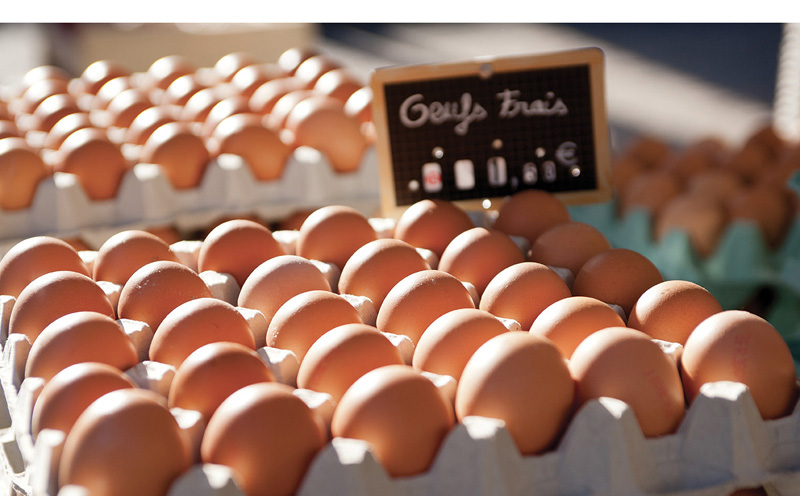
Writing this book prompted us to find the answer to a question that has bothered me for decades: In France and other countries where I’ve lived, almost everyone keeps their fresh eggs right on the counter. In fact, I have two antique wire baskets that were designed for that purpose. In America, everyone I know keeps eggs in the refrigerator. Why is that? Because our refrigerators are bigger? Because our government rules demand it? Because French chickens, like French people, are just naturally more elegant? Are you curious beyond belief right now? Let me help you out. In America, our commercial eggs are washed clean of their natural cuticle outside the shell. In France, the cuticle remains and so the egg is protected from outside elements. An unwashed egg can last for up to a month on the counter, whereas a washed egg should only be unrefrigerated for one day. Whew! One more of life’s mysteries solved. Now, if I can just find out why my omelets are never quite as tender as Deborah’s, I’ll be a happy egghead.
Butter (Beurre)
I love to write, cook, and eat. That said, do you have any idea what a sacrifice I am making for you readers? Every day I am forced to think, read about, look at photos of, and write about food. So let’s just say that the thought of watching the beckoning interior crevices of a fragrant, hot, crunchy baguette embrace the sweet, slightly sour, silken dribble of melting French butter almost makes me weep with desire.
French butter is different from any other on earth. There are literally thousands of butters to be found all over the country, and each has its own particular characteristics. The high quality of the cream makes the difference. Also, the cows’ diet makes an indelible imprint on the taste of the final product.
For instance, Isigny butter is produced in a small seaside village in Normandy. The terroir (earth) is advantageous, the climate is mild, and the fields are near salt marshes, so the grass that the cattle graze on is enriched with iodine and other minerals. That sweet, nutty, salty spread on a piece of warm French bread is worth every calorie.
Jean-Yves Bordier, the creator of Bordier butter, was the first to combine the flavor of seaweed and the plant’s lovely red, green, and black bits into butter. It’s particularly tasty paired with fish and seafood, and it can add a surprise finish to rare red meat. David Lebovitz, the celebrated food writer, admits that he refuses to let any other butter other than Bordier cross his lips! If you can’t get Bordier butter, don’t worry. Deborah has a recipe that you can use to make your own: Seaweed Butter (Beurre d’Algues) on page 95.
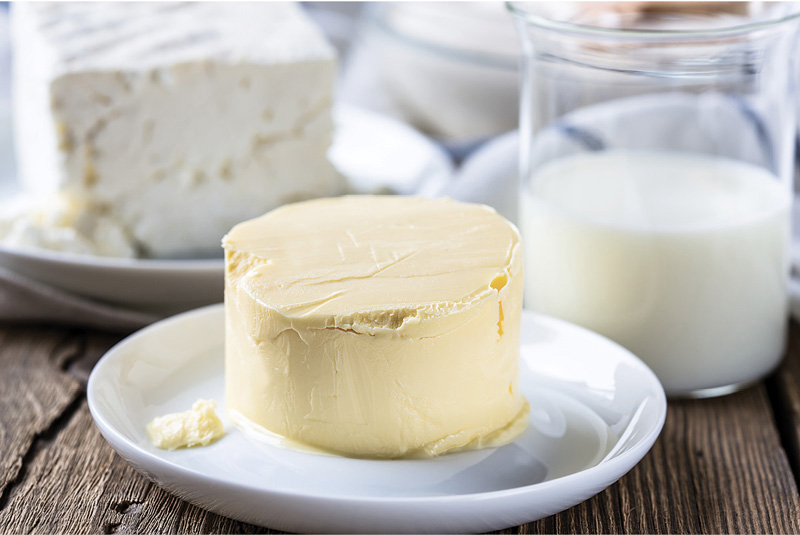
Like wine and cheese, high-end butter in France must meet certain standards to qualify for their AOC (the controlled designation of area) label. This is the French certification granted to certain products that correspond to a specific geographical location or origin. This certification assures that the product possesses certain qualities because of the terroir or because it is made using traditional methods or has a certain reputation.
Although the big-name butters from France are appreciated worldwide, many local farmers make their own sublime renditions and bring them to farmers’ markets. And they will almost certainly offer you a taste. Like eggs, butter is best kept unrefrigerated. There are many ingenious butter keepers that supply a little moisture and provide protection from light.
We always beg Deborah’s friend Nadine, who lives in Brittany, to bring butter when she comes to visit the United States. It travels very well. Shhhhhh—don’t mention this to the customs official.
Although French butters are out of this world on their own, sometimes we want to change it up and use a compound butter (butter plus other ingredients). These can take a sensational butter to the next level. Compound butters won’t be super smooth without the assistance of a food processor, but with a little elbow grease, you can make a lovely compound butter or two that will still taste divine. Always start with unsalted butter.
Yogurt (Yaourt)
Remember the part about French women and their downright magical ability to eat all that gorgeous food and remain slender? Well, here’s another one of their sneaky little tricks—they eat a lot of yogurt! Even though French yogurt is higher in fat than American yogurt, it is also much tastier and has plenty of calcium, which maintains bone density and muscle mass while encouraging fat loss. French people eat yogurt for breakfast, snacks, and sometimes for dessert. Once you taste the real thing, you’ll understand why! When you go to the supermarché, you’ll discover so many choices that you can try a different one every day and never run out of exciting new tastes.
Yogurt makes a great at-home breakfast mixed with fruit and local honey. Enjoy it with a big slice of bread topped with the famous French butters we’ve been telling you about, and you’ll be all set for the day.
The yogurt is luscious on its own, but here are some of Deborah’s ideas to enhance your meal. Try various combinations:
• Chopped fresh fruit, almost any fruit
• Roasted nuts or seeds
• Local honey
• Dried fruit
• Granola
• Jam or compote
• Toasted coconut
• Cucumber and mint
• Deborah’s personal favorite combination is fresh blueberries, honey, fresh mint, and an orange quarter squeezed over the top.
 YOGURT (Yaourt)
YOGURT (Yaourt)
Cherry (Cerise) Compote
 makes about 1½ cups (360 ml)
makes about 1½ cups (360 ml) 
This cherry compote is a versatile recipe that you can make ahead. Try it on your morning yogurt (the little shot of wine will start your day right) or on crêpes, pound cake, a cheese plate, or over ice cream. The only fiddly part of this preparation is pitting the cherries. Your rental most likely will not have a cherry/olive pitter, so you’ll have to improvise. Place an empty wine or beer bottle in a bowl to catch the juice. Put a cherry on top and use a chopstick, straw, skewer, or a pastry tip to push the pit into the bottle. You now have a pitted cherry. Keep going until you have enough. If you’re traveling with kids, this is a nice little chore to keep them busy while you sip your afternoon champagne.
Ingredients
1 pound (450 g) fresh cherries, pits removed, barely chopped
¼ cup (60 ml) red wine
2 tablespoons (30 ml) Cognac or Calvados
2 tablespoons (30 ml) orange juice
¼ cup (50 g) sugar
2 tablespoons (30 ml) honey
1 teaspoon (3 g) orange zest
Pinch of salt
Equipment
Jar with lid
Measuring cups and spoons
Medium pot
Method
1. Put all ingredients in a pot and simmer until reduced, about 20 minutes. The liquid should be syrupy. If it’s not, continue simmering and check the consistency every 10 minutes. Then let cool.
2. Store in a jar or a small bowl, covered, and enjoy all that goodness any time you like.
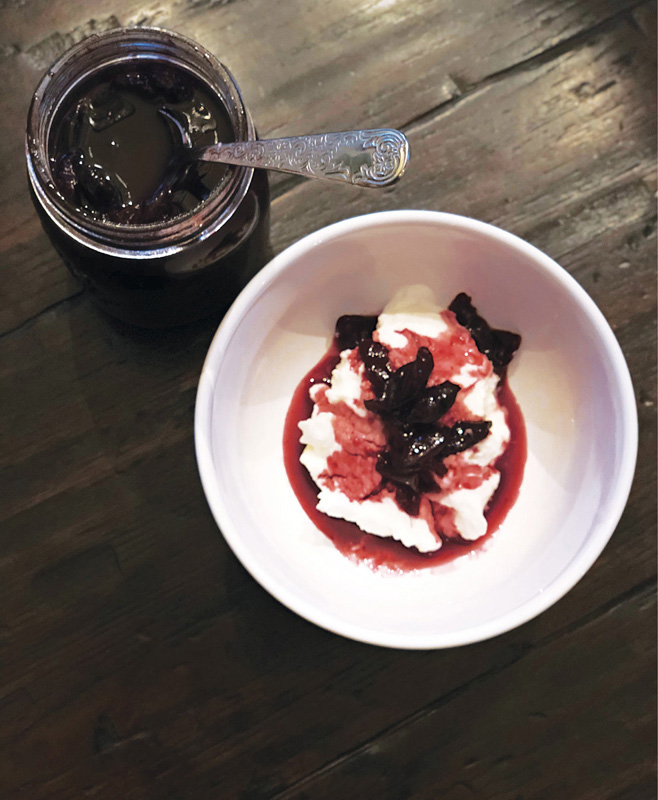
 EGGS (Oeufs)
EGGS (Oeufs)
ONCE YOU HAVE TRIED Deborah’s crustless quiche, you’ll never make those soggy overnight breakfast casseroles again. I never thought of crab for breakfast before in my life, but since I was introduced to a crab tartine it has become one of my most vivid cravings.
Sweet Potato (Patate Douce), Sausage (Saucisse), and Shallot (Echalote) Crustless Quiche
 serves 6
serves 6 
This is the best quiche ratio of egg to cream. You can make it with a crust if you have the time and inclination, but Deborah usually makes it crustless. If you do decide to use a crust, par bake it before filling with the quiche mixture. It can be made in a quiche pan, a pie plate, a cast-iron pan (her favorite), muffin tins, or individual soufflé dishes.
Ingredients
Filling
2 chorizo sausages (raw), removed from casing
6 shallots, cut in 6 to 8 pieces each
Butter (if necessary)
1 sweet potato, cut into 1/4-inch (6 mm) dice
Salt
Pepper
Equipment
Knife
Medium sauté pan or cast-iron pan (preferred)
Mixing bowl
Slotted spoon
Whisk (or fork)
EGG MIXTURE
The rule of thumb is ½ cup (120 ml) half-and-half or cream for each egg. You can feel free to use more of each if your cooking vessel is larger. Make sure to adjust your seasonings.
3 large farm fresh eggs
1½ cups (350 ml) cream or half-and-half
Pinch of nutmeg
Pinch of coriander (optional)
½ teaspoon (2.5 g) salt
Pepper
¾ cup (170 g) grated Comté or Cantal Jeune cheese (or another mild-medium cheese)
Method
Filling
1. In a medium sauté pan, cook the saucisse chorizo on medium heat until crumbly and cooked through. Remove chorizo from pan with slotted spoon.
2. In the same pan, using the grease from the chorizo, sauté the shallots on medium-low until nicely caramelized. Remove from pan with a slotted spoon.
3. Again in the same pan, add some butter if most of the chorizo grease is gone, and sauté the sweet potatoes until golden and cooked through. (You can also cook these, tossed in butter, salt, and pepper, in an oven at 350°F (180°C) in a single layer on a baking sheet.) Season with salt and pepper and set aside.
4. Mix the chorizo, shallots, and sweet potatoes together and place in your greased baking pan of choice. Don’t overfill the pan. Depending on the sizes of the chorizo and sweet potato, you may have too much filling mixture. It should not fill more than one-quarter of your baking pan. Use the remaining mixture for another use, such as in scrambled eggs or a delicious tartine.
Egg mixture
1. Preheat oven to 300°F (150°C).
2. Whisk the eggs, cream, nutmeg, coriander, salt, and pepper together thoroughly.
3. Pour the egg mixture over the filling ingredients in the pan, sprinkle with cheese, and bake until no longer wiggly in the middle. Do not turn up the heat and do not overcook. This will turn out silky and custardy if cooked properly. If not, the eggs may scramble a bit. Don’t worry if this happens because it will still be delicious.
Variations, Ideas, Suggestions A quiche is a super way to use up whatever leftover ingredients you have in your refrigerator, such as tomatoes, herbs, garlic, onions, or spinach. Here are some combinations to try:
• Roasted tomato, basil, and chèvre
• Lardons and asparagus
• Mushroom and Gruyère
• Caramelized garlic, spinach, and Cantal cheese
• Use your imagination!

Crab (Crabe) and Poached Egg Tartine
 serves 4
serves 4 
If you bought too much crab and mâche (lamb’s lettuce), use them for breakfast.
Ingredients
4 eggs
Four 1-inch-thick slices of good quality brown bread
4 tablespoons (60 ml) butter, plus extra for toast
1 cup (250 ml) cooked fresh crab meat
1½ cups (375 ml) mâche
¼ lemon for squeezing, or grapefruit juice
Sea salt
Equipment
Medium sauté pan
Slotted spoon
Small sauté pan or saucepot
Method
1. In the small pan, poach the eggs slowly. Do not overcook.
2. While the eggs are cooking, toast the bread slices in a pan on medium heat with a bit of butter on each side. Place on four plates.
3. Add 4 tablespoons butter to the bread-toasting pan on medium heat and let brown. Turn off heat.
4. Barely warm the crab meat in the brown butter and spoon on top of the toasts.
5. Fish out the poached egg with a slotted spoon and place a well-drained poached egg on top of the crab. Drizzle with the browned butter from the pan. Place some mâche on top and squeeze a bit of lemon) on top.
6. Sprinkle with sea salt. Devour!
 BUTTER (Beurre)
BUTTER (Beurre)
IF YOU THINK that there are just two kinds of butter, salted and unsalted, let us open the door to whole new world of flavors. Deborah showed us how to elevate butter into a flavor enhancer you’ll want to keep in your refrigerator all the time.
Tarragon Butter (Beurre d’Estragon)
 makes about ½ cup (120 ml)
makes about ½ cup (120 ml) 
This will take salmon, poultry, and steak to a new level.
Ingredients
1 tablespoon (15 g) very finely minced tarragon
3-4 drops fresh lemon juice
Sea salt
8 tablespoons (120 ml) unsalted butter, softened
Equipment
Bowl
Fork
Knife for mincing
Method
1. With a fork, mix and mash the tarragon, lemon, salt, and butter together until smooth.
2. Taste and add more salt or lemon if necessary.
3. Refrigerate until ready to use.
Anchovy Butter (Beurre d’Anchois) and Radishes (Radis)
 makes about ½ cup (120 ml)
makes about ½ cup (120 ml) 
This is a French classic, with the addition of the anchovies. The butter is also amazing slathered on a steak or tossed with roasted potatoes.
Ingredients
1 anchovy, finely minced, or 1 tablespoon (5 ml) anchovy paste
8 tablespoons (120 ml) unsalted butter, softened
A few drops of lemon juice
12 farm fresh radishes, cleaned with a little bit of the green tops still attached
Sea salt
Equipment
Knife for mincing and mashing
Bowl
Fork for mixing and mashing
Method
1. With a fork or the edge of a chef’s knife, mash the minced anchovy until it resembles a paste.
2. Mix and mash with the butter and lemon juice until blended and smooth.
3. Refrigerate until ready to use. Serve softened with fresh radishes.
4. Or, dip radishes in the softened butter, sprinkle with sea salt and refrigerate until ready to eat.
Seaweed Butter (Beurre d’Algues)
 makes about ½ cup (120 ml)
makes about ½ cup (120 ml) 
Wonderful on shellfish, tossed with rice, or melted and drizzled hot over raw oysters. Try with roasted mushrooms or slathered on crusty bread.
Ingredients
1 tablespoon (15 ml) very finely minced dulse
3-4 drops fresh lemon juice
Sea salt to taste
8 tablespoons (120 ml) unsalted butter, softened
Equipment
Baking pan
Bowl
Fork
Knife for mincing
Sauté pan, if necessary
Method
1. Preheat oven to 225°F (110°C). Roast the dulse in a single layer on a baking pan until dry and crisp. Let cool a bit, then finely mince or crumble. If it’s already dry, mince or crumble it and then toast lightly in a sauté pan.
2. With a fork, mix the dulse, lemon juice, and salt with the butter together until smooth.
3. Refrigerate until ready to use.
Variations, Ideas, Suggestions If your fishmonger doesn’t have dulse or any other seaweed, and you happen to have some nori, toast and crumble an equivalent amount of that instead. If you happen to have a mortar and pestle available, grind the seaweed to a fine powder.
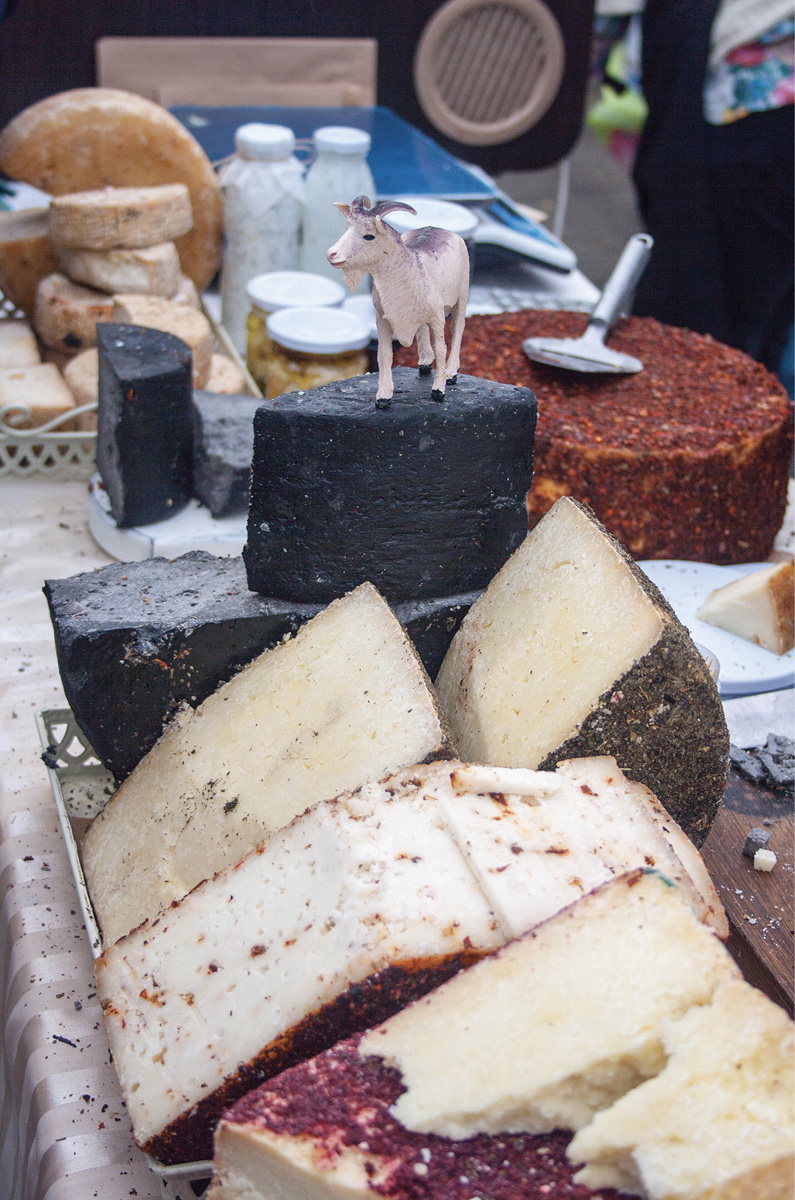
CHEESE FESTIVALS
